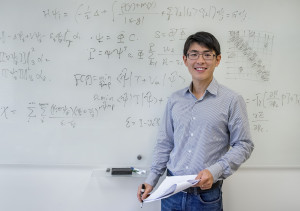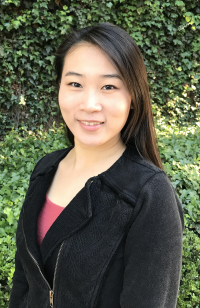Alvarez Fellows: Outstanding in Their Fields

Lin Lin is now an associate professor at UC Berkeley and a Berkeley Lab faculty researcher who focuses on developing numerical methods for electronic structure calculations with broad applications in quantum chemistry, quantum physics, and materials science.
Since its founding in 2002, the fellowship has cultivated exceptional young scientists who have made outstanding contributions to computational and computing sciences as researchers, professors, and in the private sector.
A selection of vignettes about Alvarez Fellow alumni are presented below. For a full list of past fellows and where they are now, visit the main information page, scroll down, and select "The Fellows" to expand the section.
Alvarez fellow Jarrod McClean ('15) is now a research scientist in the Google Quantum Artificial Intelligence Laboratory, where he works on quantum computation, quantum chemistry, numerical methods, and information sparsity.
Juliane Mueller ('14) first joined Berkeley Lab as a research scientist working on optimization methods applied to vehicle routing, structural optimization, renewable energy, watershed management, optimal reliability design, and global climate models. She currently manages the Artificial Intelligence, Learning, and Intelligent Systems (ALIS) group at the National Renewal Energy Laboratory in Colorado.

2019 Alvarez Fellow Jackie Yao worked on multi-physics simulations at the Center for Computational Sciences and Engineering (CCSE).
Many Alvarez fellows have been appointed professors. Lin Lin ('11) is now an associate professor in the Department of Mathematics at the UC Berkeley. He also continues to conduct research with Berkeley Lab as a faculty scientist. Lin received a Department of Energy Early Career Award in 2017 and the Presidential Early Career Award for Scientists and Engineers (PECASE) in 2019.
Didem Unat ('12) is an assistant professor in the Computer Science and Engineering Department at Koç University in Istanbul, Turkey. She directs the Parallel and Multicore Computing Laboratory (ParCoreLab) at the university and remains a Berkeley Lab-affiliated researcher. In 2021 she was named Emerging Woman Leader in Technical Computing by the Association of Computing Machinery (ACM) Special Interest Group on High Performance Computing (SIGHPC).
“Being a Luis Alvarez Fellow and being part of the Combustion Co-design Center allowed me to build research, communication, and organizational skills,” said Unat. “I appreciate everybody with whom I interacted at Berkeley Lab. They greatly helped me build my career and prepare me for my new position.”
Tess Smidt ('18) is now the X-Window Consortium Professor, assistant professor in MIT's Department of Electrical Engineering and Computer Science.
Former fellow Anubhav Jain ('10) is now a Berkeley Lab staff scientist focusing on new materials discovery using high-throughput computations. He serves as thrust lead for the Materials Project, a multi-institution effort to accelerate materials discovery by computing the properties of all known inorganic properties. Scientific American has named this emerging field a “World Changing Idea.” Jain received a DOE Early Career Research Program award in 2015. As an Alvarez Fellow, Jain created the FireWorks framework for automating calculations at supercomputing centers.

Former Alvarez Fellows Juliane Mueller and Jarrod McClean: Mueller is now a research scientist at the National Renewable Energy Laboratory (NREL). McClean is a researcher for Google.
Many Alvarez fellows choose to join the Berkeley Lab Computing Sciences Area as career scientists. Aydın Buluç ('10) is a rising star in DOE. In 2013, Buluç was honored DOE Early Career Award for his work on energy-efficient parallel graph and data mining algorithms. He used the award to explore methods of increasing the energy efficiency of parallel algorithms and data mining tasks. He will also develop a new family of algorithms to drastically reduce the energy footprint and running time of graph and sparse matrix computations that form the basis of various data mining techniques. As an Alvarez fellow, Buluç’s research focused on high-performance graph analysis, libraries, and their applications in genomics and bioinformatics, parallel sparse matrix computations, and communication-avoiding algorithms.
Lavanya Ramakrishnan ('09) is a research scientist and division deputy for the Scientific Data Division (SciData). One of her most visible projects was a collaboration with Google to develop free models for assessing energy efficiency in computing. A six-month study led by Ramakrishnan in 2013 found that moving common software applications used by 86 million U.S. workers to the cloud could save enough electricity annually to power Los Angeles for a year. As an Alvarez fellow, Ramakrishnan evaluated cloud computing technologies and infrastructure for scientific applications. Her findings were published in DOE’s widely anticipated 2011 Magellan Report on Cloud Computing for Science.
Former fellows Joshua Schrier ('05) and Kamesh Madduri ('08) became professors, conducting their own research while training new generations of researchers. Schrier is a professor at Fordham University, holding the Bepler Chair in Chemistry. His research focuses on accelerating the discovery of new materials using a combination of physics-based simulations, cheminformatics, machine learning, and automated experimentation. In the classroom, he champions integrating modern computational techniques into the chemistry curriculum at all levels. As an Alvarez Fellow, he worked with Berkeley Lab’s Lin-Wang Wang to use high-performance parallel plane-wave pseudopotential density functional methods to study nanostructures.
An associate professor at Pennsylvania State University, Madduri is the principal investigator and director of the Scalable Computing Laboratory. The lab’s mission is to develop scalable parallel algorithms to accelerate irregular data-intensive computations. Its current research areas include graph analytics, computational biology, and bioinformatics, applied machine learning, and high-performance scientific computing. He was honored with the SIAM Activity Group on Supercomputing Junior Scientist Prize in 2010 and a National Science Foundation (NSF) Career Award in 2013. As an Alvarez fellow, he worked under the guidance of Berkeley Lab's Arie Shoshani on developing parallel graph algorithms and massive scientific data analysis.







 Instagram
Instagram YouTube
YouTube